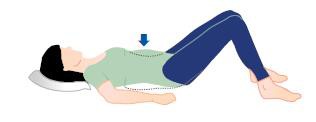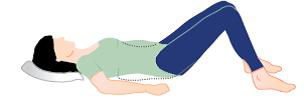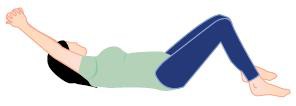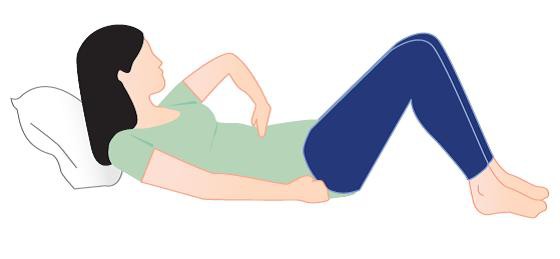Abdominal excercises
Return to exercise
If you have had a caesarean section or had limited mobility during pregnancy, please contact your doctor or midwife before resuming activities. All return to exercise should be on a gradual pain-free basis. Walking is a terrific exercise, so when you feel able, start with a slow pain-free 10 minute walk. As you regain strength, you can increase the length, frequency and speed of the walks. Taking your pelvic floor to the third floor and holding for 20 seconds as you walk is a great way to exercise your pelvic floor. However, remember to fully relax it between exercises as failure to release the muscle fully between contractions can lead to dysfunction of the muscle.
Abdominal muscles
You may start the following exercises within days of the birth as long as they are pain-free and do not cause strain. Aim to do the exercises twice a day.
1. Deep tummy exercise
Lie on your back with your knees bent;
- Breathe in; as you breathe out, gently draw your lower abdomen in towards your spine.
- Hold for a few seconds, breathing normally, then relax. Be careful not to move your back or pelvis.
- Start holding for 5 seconds and progress to holding for 10 seconds as you get stronger.
- Repeat 10 times.
- Try drawing in your pelvic floor at the same time if possible.
This exercise can also be done, while sitting and standing, once you have mastered it in lying.
 Abdominal exercise 01
Abdominal exercise 01
2. Pelvic tilt
With your head on a pillow, lie on your back with knees bent and feet flat on the bed:
- Draw in your belly button and gently flatten your lower back into the bed.
- As you flatten your back your buttocks will gently raise up off the bed.
- Hold this position for 5-10 seconds (it is important not to hold your breath), then gently let go.
- Repeat 10 times.
Once you have mastered this exercise, it can be practised in any position, side-lying, sitting or standing.

3. Shoulder and upper spine stretch
- Repeat exercise 2.
- While your back is flat against the bed, clasp hands and bring arms up over head.
- Do not allow back to lose contact with the bed and do not push into pain.
- Return to starting position.
- Repeat 10 times.

4. Clam exercise for glutes
Lying on side with knees bent:
- Draw in belly button and raise top leg upwards keeping feet together.
- Keep pelvis steady and feet together as you raise your leg upwards.
- Return to starting position.
- Hold from 1-10 seconds and repeat 10 times.

Initially after having a baby your tummy muscles remain stretched and lengthened down the centre of your abdomen leaving a gap in the middle which may take some weeks to close. Before progressing with the exercises, you need to ensure that there isn’t a gap or hollow in your tummy muscles. This can be done as follows:
- Lie on the floor with your knees bent and gently place the finger tips of one hand down and into your abdomen just 2 finger widths above your tummy button.
- Take your pelvic floor muscles to the third floor as described earlier, then lift your head and shoulders towards your toes, breathing normally as you do this.
- You may feel a slight gap which closes across your fingers as your head lifts. If this gap has not closed at 6 weeks postnatally, you should get your GP to refer you to a Chartered Physiotherapist who can show you how to deal with this problem effectively.

Increase the number of repetitions as you feel able:
- Remember to listen to your body
- Stop if it hurts
- Stop when tired
- Remember to practice good posture and back care
- At times of stress remember to practice relaxation
If you need advice about increasing activity or to determine if you are ready to resume sporting activities, please ask your GP, or contact your Chartered Physiotherapist in Women’s Health.
Some important things to know about babies
The World Health Organisation Guidelines recommend that babies should be placed on their backs for sleep to reduce the risk of cot death. It is very important to follow this advice. However, it is extremely important that babies spend some time on their tummies every day.
Why should babies have tummy time?
- They achieve better head control and stronger muscles in their neck, shoulders, arms and backs.
- Babies move from side to side on their tummies which helps them learn how to reach and crawl.
- They develop better balance and co-ordination.
- Vision and hand-eye co-ordination are enhanced.
Babies should be placed on their tummies from day 1, for just a few minutes three times daily initially, gradually building up the length of time. Initially, you can place your baby on your chest, facing you. This is a great way to play with your baby, and to make eye contact with him, which is one of the first steps in communication with your baby. Your baby may not like being on his tummy initially, so start slowly, but persevere! The benefits to your baby are worth the effort.
Your baby should NEVER BE LEFT ALONE while on his tummy.
Too much time on their backs can cause a delay in babies acquiring movement skills, and can also cause flattening of the side of their head. To avoid this, alternate which end of the cot you place the baby’s head at night; babies will naturally turn towards the light or coloured objects in the room which will change the area of pressure on the baby’s head.
The best piece of equipment you can invest in for your baby is a colourful mat to place on the floor, so that he can enjoy his tummy time on it while exploring his environment in your company!
It is very important to engage with your baby by using eye contact. With your baby lying on a flat surface, or on your tummy as in the image above, encourage your baby to make eye contact with you in mid-line (ie. when your baby’s nose is in line with your baby’s belly button).
Encourage your baby to follow your face from side to side and up and down, coming back to mid-line after each movement. This is the start of communication and head control.
Floor time: The floor is the best place for your baby to spend his awake time. This may be difficult if you have young toddlers, but a playpen can overcome this difficulty. Your baby needs time on the floor, completely unsupported and with as little clothes on as possible to become familiar with their bodies and their ever developing movements. Between the ages of 0 and 2, if your baby is not asleep, he should be moving. This is how he develops and begins to learn.
Nutricia offers access to a wide range of support services and resources including:
- • Our free Sampling Service to order product samples and have them sent to your patients' homes.
- • A range of CPD accredited e-learning programmes.
- • Order free paper copies of our support tools for yourself or to use with your patients.
- • Sign up to receiving marketing communications and be the first to know about our free educational events & webinars, the latest scientific research and product updates.
